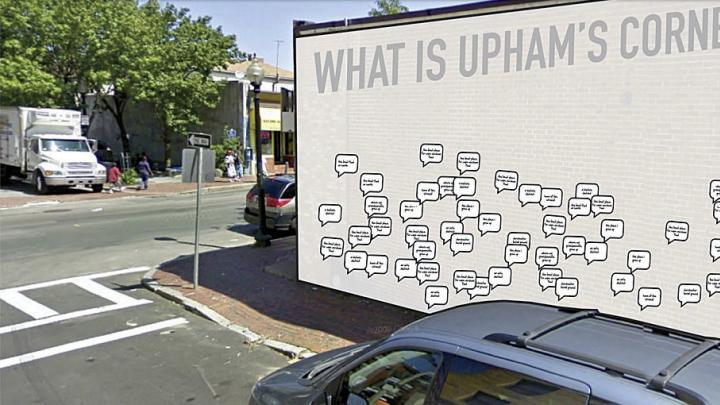Imagine a large blank bulletin board hanging in the middle of Upham’s Corner in Dorchester covered with stickers that read “Upham’s Corner is…the best Cape Verdean food” or “Upham’s Corner is…the place I grew up”—designed to spark discussions about community identity. Or a themed website for the Strand Theater there that would host a resource portal with a local feel—to attract neighborhood businesses. Or interactive, multi-touch panels running along both sides of the entryway of the affordable-housing project Orchard Gardens—to serve as a community spotlight and increase residents’ engagement.
In the fall class “Solving Problems Using Technology,” students from Harvard’s Kennedy School (HKS) and Graduate School of Design (GSD) teamed up with three community groups in Boston and the Mayor’s Office of New Urban Mechanics to make these “big ideas” a reality in the Dudley and Upham’s Corner neighborhoods.
Guided by visiting Stanton professor of the First Amendment Susan Crawford and assistant professor of urban planning Michael Hooper, GSD and HKS students worked together in nine different interdisciplinary teams to enhance projects already undertaken by their partner community groups and to develop their own unique ideas for addressing urban and civic challenges. At the end of the semester, the teams presented their projects to their community partners, community residents, and mayoral representatives at Hibernian Hall in Dudley Square. The mayor’s office, Crawford said, will implement the best of the student designs.
The GSD students focused mainly on participatory planning and design, the HKS students on implementation of the ideas. The “novel and exciting” structure of the class, Hooper says, brings students with various interests together and gives them direct experience in solving real community issues. In groups of four to six, students tackled questions such as how can an affordable-housing project serve as a model for a twenty-first-century public space and involve residents in the design process? How can the housing project’s board form a strong link between residents and City Hall? What can be done to draw people from other parts of Boston to shop, eat, and see a show in Upham’s Corner? How can technology enhance the visual identity of this area?
Students began by learning about the Dudley area before homing in on specific community needs with their partners—the Dudley Street Neighborhood Initiative, the Orchard Garden Residents Association, and the Upham’s Corner Main Street Initiative—and brainstorming solutions, narrowing their focus to one “big idea” they deemed most workable. The second half of the course was the lab portion—a user-centered design class that brings all the students together in Harvard’s I-Lab to work on their projects. “A lot of projects at the end of a term go on your C drive, they’ve been a great experience, but that’s the end,” Hooper said during the first class meeting. “The hope here is that these projects can see the light of day, be implemented, and live beyond your computer.”
One group’s members—Alex Tischenko, Jean You, Beth Lundell Garver, and Rodrigo Davies—focused on a way to make Dorchester North Burying Ground, one of the oldest cemeteries in the country, a recognized landmark and a stronger asset to the Upham’s Corner community. Their solution was to transform the “experience on the ground” through an annual community day bridging economic, cultural, and generational boundaries: “Living Souls Day”—an event in collaboration with local arts groups featuring dance performances, food, music, and fun. “We want to work with these groups to co-design a story and interactive production,” said You during the group’s presentation at Hibernian Hall in December. “It will be a cultural celebration…we see this as a way to transform the site and really make it attractive.”
Leslie Feinberg, Jake Cummins, Alix de Zelicourt, and Karina Qian concentrated on ways to empower the Orchard Gardens Residents Association, to ensure its relevance and service to the community. Their idea was the “Walk of Stars”—the interactive, multi-touch wall display in the housing project’s entryway. The display would offer different kinds of content: information on events, board-member profiles, media stories around the community, even birthdays. An interactive floor would control many of the digital screens—as people stepped on different tiles, different displays would pop up. “We want the lobby to serve as this fun, highly engaging place,” said Cummings. “The metaphor is that you are walking through this corridor into the future.”
The Mayor’s Office of New Urban Mechanics will announce the projects it decides to fund in January.








